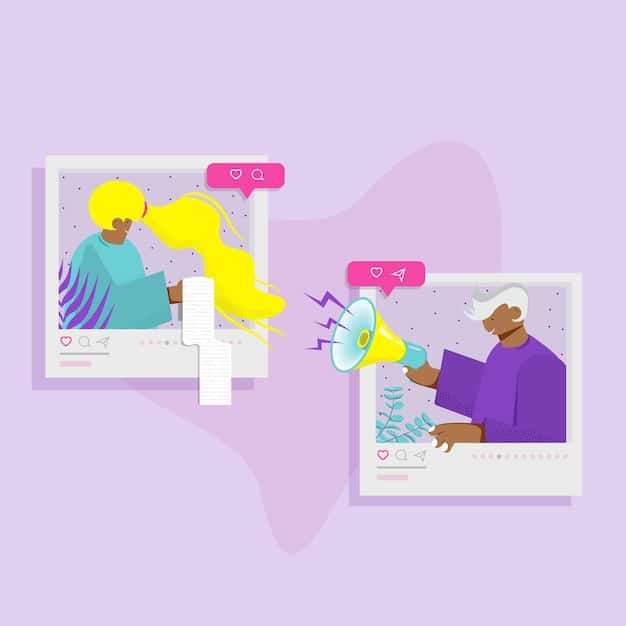The Video That Divided the Nation: Controversy & Aftermath

Anúncios
The Viral Video That Divided the Nation: Examining the Controversy and Its Aftermath refers to a situation where a video quickly spreads across the internet, sparking significant disagreement and debate among viewers, reflecting deep-seated social or political tensions.
The internet has a knack for turning ordinary moments into extraordinary debates, and no phenomenon exemplifies this more than a viral video that divided the nation: examining the controversy and its aftermath. These videos, often surfacing unexpectedly, ignite discussions that quickly spread across social media, news outlets, and even everyday conversations.
Anúncios
Understanding the Anatomy of a Viral Video
Before diving into the specific controversies, it’s crucial to grasp what makes a video go viral. It’s not simply about luck; several factors contribute to a video’s widespread dissemination. Understanding these elements provides insight into why certain videos spark such intense reactions and divide opinions.
Key Elements of Virality
Virality often hinges on emotional resonance. Videos that evoke strong feelings, whether positive or negative, are more likely to be shared. Additionally, relevance to current events or popular culture can significantly boost a video’s reach.
Anúncios
The Role of Social Media Algorithms
Social media algorithms play a crucial role in determining which videos gain traction. These algorithms prioritize content based on user engagement, such as likes, shares, and comments. Consequently, videos that initially attract attention are more likely to be amplified and reach a wider audience.
- Authenticity: Genuine and unscripted moments often resonate more deeply.
- Relatability: Videos that reflect common experiences or concerns tend to be widely shared.
- Surprise: Unexpected twists or humorous content can generate significant buzz.
Ultimately, a combination of these factors, coupled with a bit of serendipity, often leads to a video achieving viral status. However, the very elements that make a video popular can also contribute to its controversial nature.

The Spark: What Ignites the Controversy?
A seemingly innocuous video can quickly become a lightning rod for controversy. This often occurs when the content touches upon sensitive social, political, or cultural issues. The context in which a video is shared and interpreted can significantly amplify its impact, turning a simple moment into a national debate.
Videos that challenge deeply held beliefs or values are particularly prone to generating controversy. Whether it’s a clip that highlights social inequality, a political statement that polarizes opinions, or a cultural practice that sparks debate, these videos tap into existing tensions and disagreements within society.
Political Polarization
In today’s highly politicized environment, even seemingly non-political videos can be interpreted through a partisan lens. What one person sees as harmless humor, another might view as offensive political commentary.
Social Justice Issues
Videos that address issues such as racial injustice, gender inequality, or LGBTQ+ rights can quickly ignite passionate debates. These debates often reflect broader societal conflicts and differing perspectives on these complex issues.
The speed at which information spreads online also contributes to the intensity of the controversy. A video can be viewed and shared millions of times within hours, leading to a rapid escalation of opinions and emotions.
- Misinterpretation: Videos can be easily taken out of context, leading to misunderstandings.
- Echo Chambers: Social media algorithms often reinforce existing beliefs, creating echo chambers where dissenting opinions are rarely encountered.
- Emotional Amplification: Online interactions can amplify emotions, making discussions more heated and confrontational.
Understanding the underlying factors that ignite controversy is essential for navigating the aftermath of a viral video. It helps to contextualize the reactions and opinions expressed, and to foster more constructive dialogue.
Case Studies: Viral Videos That Divided the US
Examining specific examples of viral videos that have sparked national controversy provides valuable insights into the dynamics at play. Each case offers unique lessons about the power of online content to influence public opinion and ignite social debates.
One notable case is the “Covington Catholic” video, which surfaced in 2019. The clip showed a group of high school students wearing “Make America Great Again” hats interacting with a Native American elder. Initial interpretations of the video led to widespread condemnation of the students, but later, a more complete picture emerged, revealing a more complex sequence of events.
The “Covington Catholic” Controversy
The “Covington Catholic” video serves as a cautionary tale about the dangers of jumping to conclusions based on incomplete information. The initial outrage was fueled by a selective editing of the footage, which misrepresented the students’ actions and intentions.
The “United Breaks Guitars” Incident
Another example is the “United Breaks Guitars” video, created by a musician whose guitar was damaged by an airline. The video, which humorously criticized the airline’s customer service, quickly went viral and caused significant reputational damage to the company.
- “Pizza Rat”: A video of a rat dragging a slice of pizza down the stairs of a New York City subway became symbolic of urban life and generated endless discussions online.
- “Charlie Bit My Finger”: The short video of a baby biting his older brothers finger became one of the most-watched videos of its time.
- “David After Dentist”: A young boy’s hilarious reaction to his dentist visit post-anesthesia has been viewed over 140 million times.
These case studies demonstrate the diverse ways in which viral videos can spark controversy and divide opinions. From misinterpretations of events to criticisms of corporate practices, these videos highlight the power of online content to shape public discourse and influence the national conversation.

The Aftermath: Impact on Individuals and Society
The effects of a viral video can extend far beyond the initial online frenzy. Individuals featured in controversial videos often face intense scrutiny and personal attacks, while society grapples with the broader implications of the issues raised.
For those directly involved in a viral video, the experience can be incredibly challenging. They may be subjected to online harassment, doxxing (the release of personal information), and even threats of violence. The psychological toll of this kind of attention can be devastating.
Personal Consequences for Those Involved
The “Covington Catholic” students, for example, faced widespread condemnation and threats before the full story emerged. Their reputations were tarnished, and their families endured significant emotional distress.
Societal Impact of Viral Controversies
Beyond the personal consequences, viral controversies can have a lasting impact on society. They can exacerbate existing divisions, erode trust in institutions, and contribute to a climate of polarization.
The rapid spread of misinformation and the amplification of extreme views can further complicate matters, making it difficult to have constructive dialogue. Moreover, the focus on individual incidents can sometimes distract from the broader systemic issues that need to be addressed.
- Increased Awareness: Viral videos can raise awareness about important social or political issues.
- Promoting Dialogue: Controversies can spark important conversations and debates.
- Driving Change: In some cases, viral videos can lead to concrete policy changes or reforms.
While viral controversies can be challenging and divisive, they also present opportunities for growth and progress. By fostering critical thinking, promoting empathy, and encouraging respectful dialogue, we can harness the power of online content for positive change.
Navigating the Storm: Strategies for Responsible Engagement
Given the potential for viral videos to ignite controversy and divide opinions, it’s essential to approach these situations with a sense of responsibility and critical thinking. Both individuals and organizations can play a role in fostering more constructive online discussions.
One crucial step is to verify information before sharing it. In the age of fake news and misinformation, it’s easy to be misled by sensationalized or inaccurate content. Taking the time to fact-check information and consult multiple sources can help prevent the spread of false narratives.
Verifying information
Checking multiple sources is essential, especially for emotionally charged topics.
Practicing Empathy
Perspective takes place between parties allows for better and more civil understanding.
Individuals can also prioritize respectful communication and avoid engaging in personal attacks or online harassment. Remember that behind every screen is a real person with feelings and emotions.
- Critical Thinking: Develop the skills to evaluate sources and check their reliability.
- Civic Engagement: Engage in respectful conversations with those who hold different views.
- Promoting Tolerance: Actively combat online hate speech and discrimination.
By adopting these strategies, we can help create a more informed, empathetic, and constructive online environment. It’s not about avoiding difficult conversations, but rather about engaging in them in a responsible and respectful manner.
Looking Ahead: The Future of Viral Content and Controversy
As technology continues to evolve, the landscape of viral content and online controversy is likely to change as well. Emerging trends, such as artificial intelligence and virtual reality, could present new opportunities and challenges.
AI-generated videos, for example, could blur the lines between reality and fiction, making it even more difficult to discern what is real and what is not. This could have significant implications for the spread of misinformation and the manipulation of public opinion.
The Rise of AI-Generated Content
Deepfakes may influence the ability for critical thought and debate.
Virtual Reality and Immersive Experiences
Experiences can alter how someone perceives interactions.
Staying informed about these developments and adapting our strategies accordingly is crucial for navigating the future of viral content and controversy. It’s about fostering digital literacy, promoting ethical online behavior, and ensuring that technology serves humanity, rather than the other way around.
- Promoting Media Literacy: Educate people about how to critically evaluate online content.
- Developing Ethical Guidelines: Establish standards for the creation and dissemination of AI-generated content.
- Strengthening Social Media Regulation: Enforce rules to ban hate speech and remove violent content.
By embracing these principles, we can harness the power of technology for good and create a digital landscape that is more inclusive, informative, and respectful.
| Key Point | Brief Description |
|---|---|
| 🔥 Viral Videos | Content that rapidly spreads and gains immense popularity online. |
| 🤔 Controversy | Disagreement or public dispute arising from a video’s content. |
| 🗣️ Public Opinion | Views or attitudes held by the public about the video and related issues. |
| 🌐 Social Impact | The effects that viral videos have on cultural discourse and society. |
Frequently Asked Questions
▼
Viral videos often evoke strong emotions or tap into current trends, making them highly shareable. Their spread is also amplified by social media algorithms.
▼
When videos touch on sensitive topics like politics or social justice, they can spark debates and division among viewers with differing opinions.
▼
The ‘Covington Catholic’ video and ‘United Breaks Guitars’ are notable cases where initial outrage gave way to broader discussion.
▼
Those involved often face intense scrutiny and harassment, affecting their reputation and emotional well-being as a result of the attention.
▼
Verify information, practice empathy, and promote respectful communication rather than engaging in personal attacks, which can prove damaging.
Conclusion
In conclusion, viral videos that divide the nation serve as powerful reflections of our society’s fault lines and highlight the importance of critical thinking and responsible engagement in the digital age. They remind us to approach online content with a discerning eye, to verify information before sharing it, and to engage in respectful dialogue even when faced with differing opinions.





